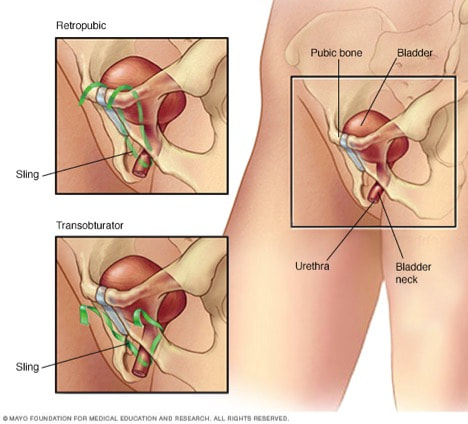Urinary Incontinence
Overview
Urinary Incontinence (UI) is the involuntary loss of urine. It is a common and often embarrassing problem affecting both women and men. It may take the form of occasionally leaking urine when you cough or sneeze, or having an accident from not making it to the bathroom in time.
There are four types of urinary incontinence: Stress Urinary Incontinence (SUI), Urge Urinary Incontinence (UUI), Mixed Incontinence (SUI & UUI), and Overflow Incontinence. Causes may differ for women and men. SUI is most common in older women, UUI affects both women and men, and Overflow Incontinence is mostly seen in men with prostate problems.
In Neurogenic UI, damage to the nerves from diabetes or neurological diseases can cause under-activity of the bladder. Stroke, Parkinson’s disease, and Multiple sclerosis affect the brain and nervous system, which can lead to urinary incontinence.
Urinary incontinence can impact emotional well-being and limit social interaction. Many people avoid normal activities such as shopping, social events, exercise, and sexual activity. The bladder is not like fine wine and cheese; it does not get better with age. We are here to help you get back to enjoying life. There are numerous treatments available for you today.
Female Incontinence
Stress Urinary Incontinence (SUI) is the most common type of urine leakage for women. About 1 in 3 women will experience SUI at some point in their lifetime. Leakage happens when you cough, sneeze, laugh, lift, exercise or even bend over. Weak pelvic muscles let urine escape during these types of activities. SUI symptoms can range from mild to severe. Conservative therapies such as Kegel exercises and lifestyle changes are recommended first.
Surgical therapies, most commonly the mid-urethral sling, is usually recommended next. Slings are made of a synthetic or biologic material that is compatible with the body. A small incision is made in the vagina to place it under the urethra. The sling provides support to the urethra and bladder to aid in eliminating urine leakage. It is an effective and minimally invasive surgical option usually performed in an outpatient setting.
Urinary Incontinence (UI) is the involuntary loss of urine. It is a common and often embarrassing problem affecting both women and men. It may take the form of occasionally leaking urine when you cough or sneeze, or having an accident from not making it to the bathroom in time.
There are four types of urinary incontinence: Stress Urinary Incontinence (SUI), Urge Urinary Incontinence (UUI), Mixed Incontinence (SUI & UUI), and Overflow Incontinence. Causes may differ for women and men. SUI is most common in older women, UUI affects both women and men, and Overflow Incontinence is mostly seen in men with prostate problems.
In Neurogenic UI, damage to the nerves from diabetes or neurological diseases can cause under-activity of the bladder. Stroke, Parkinson’s disease, and Multiple sclerosis affect the brain and nervous system, which can lead to urinary incontinence.
Urinary incontinence can impact emotional well-being and limit social interaction. Many people avoid normal activities such as shopping, social events, exercise, and sexual activity. The bladder is not like fine wine and cheese; it does not get better with age. We are here to help you get back to enjoying life. There are numerous treatments available for you today.
Female Incontinence
Stress Urinary Incontinence (SUI) is the most common type of urine leakage for women. About 1 in 3 women will experience SUI at some point in their lifetime. Leakage happens when you cough, sneeze, laugh, lift, exercise or even bend over. Weak pelvic muscles let urine escape during these types of activities. SUI symptoms can range from mild to severe. Conservative therapies such as Kegel exercises and lifestyle changes are recommended first.
Surgical therapies, most commonly the mid-urethral sling, is usually recommended next. Slings are made of a synthetic or biologic material that is compatible with the body. A small incision is made in the vagina to place it under the urethra. The sling provides support to the urethra and bladder to aid in eliminating urine leakage. It is an effective and minimally invasive surgical option usually performed in an outpatient setting.
Overactive Bladder (OAB) is characterized by urine leakage from a sudden, uncontrollable urge (Urge Urinary Incontinence, UUI). It is not the same as SUI. Please visit our OAB page for more information.
Overactive Bladder (OAB) is characterized by urine leakage from a sudden, uncontrollable urge (Urge Urinary Incontinence, UUI). It is not the same as SUI. Please visit our OAB page for more information.

